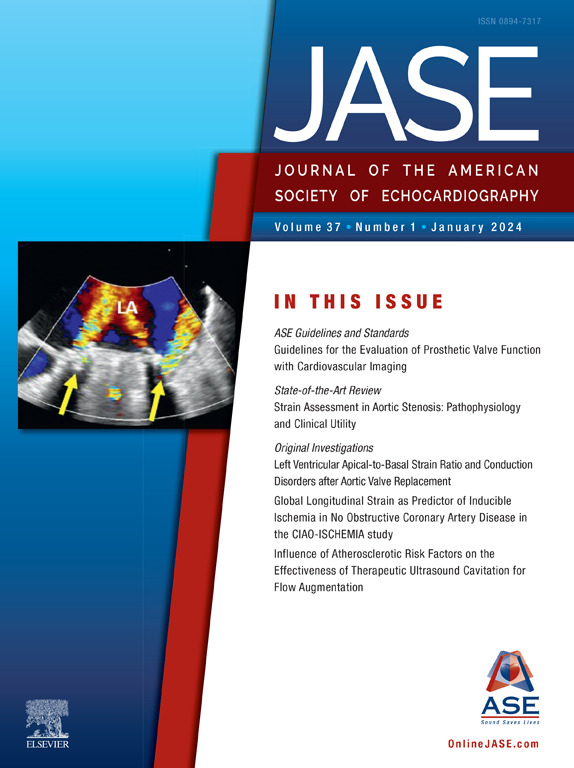Stress Echocardiography in Patients With Moderate or Severe Myocardial Ischemia: Insights From the ISCHEMIA Trial
IF 5.4
2区 医学
Q1 CARDIAC & CARDIOVASCULAR SYSTEMS
Journal of the American Society of Echocardiography
Pub Date : 2025-06-01
DOI:10.1016/j.echo.2025.03.006
引用次数: 0
Abstract
Background
This study examined stress echocardiography in relation to coronary artery anatomy and outcome in subjects randomized in the International Study of Comparative Health Effectiveness with Medical and Invasive Approaches (ISCHEMIA) trial.
Methods
Of 5,179 patients randomized to initial invasive or conservative strategy, stress echocardiography was performed in 1,079. Coronary computed tomographic angiogram (CCTA) excluded left main disease and quantified coronary lesions. Degree of ischemia was defined by number of segments with stress-induced wall motion abnormalities (mild < 3, moderate = 3, and severe > 3). Transient ischemic dilation was defined as a 10% increase in stress left ventricular end-systolic volume. Primary end point was a composite of cardiovascular death, nonfatal myocardial infarction, or hospitalization for unstable angina, heart failure, or resuscitated cardiac arrest.
Results
On CCTA, 607/715 (84%) with CCTA evaluable for ≥70% lesion had 1 such lesion. Features associated with coronary lesions ≥70% were number of ischemic/infarcted segments, 3 or more ischemic segments in the anterior territory, and inability to augment left ventricular ejection fraction 10 percentage points. Transient ischemic dilation, present in 28.5% of cases, was significantly associated with severity of ischemia. For every 0.10 increase in peak wall motion score index, there was a 12% increased risk of cardiovascular death or myocardial infarction (adjusted hazard ratio = 1.12; 95% CI, 1.04, 1.21; P = .003).
Conclusion
In patients with chronic coronary disease and moderate or severe myocardial ischemia receiving contemporary therapies, stress echocardiography identified subjects with significant coronary artery disease and wall motion score index provided prognostic value.
中度或重度心肌缺血患者的应激超声心动图:缺血试验的启示。
背景:本研究考察了应激超声心动图(SE)与冠状动脉解剖的关系,以及在国际医学和有创入路(缺血)试验中随机分配的受试者的结果。方法:5179例患者随机分为初始有创或保守策略,其中1079例进行了SE。冠状动脉计算机断层血管造影(CCTA)排除左主干病变并量化冠状动脉病变。缺血程度由出现应激性壁运动异常(WMA)的节段数(轻度< 3,中度= 3,重度> 3)来定义。短暂性缺血扩张(TID)定义为应激性左室(LV)收缩末期容积增加10%。主要终点是心血管死亡(CVD)、非致死性心肌梗死(MI)、因不稳定心绞痛、心力衰竭或复苏性心脏骤停住院的复合终点。结果:在CCTA上,607/715 (84%)CCTA可评估≥70%病变的患者有一个这样的病变。与冠状动脉病变≥70%相关的特征是缺血/梗死节段数,前区有3个或更多的缺血节段,不能增加左室射血分数10个百分点。28.5%存在TID,与缺血严重程度显著相关。峰值壁运动评分指数(WMSI)每增加0.10,心血管疾病或心肌梗死的风险增加12%(调整后HR=1.12 (95% CI: 1.04, 1.21), p=0.003)。结论:在接受现代治疗的慢性冠心病和中重度心肌缺血患者中,应激超声心动图识别明显CAD和WMSI的受试者具有预后价值。
本文章由计算机程序翻译,如有差异,请以英文原文为准。
求助全文
约1分钟内获得全文
求助全文
来源期刊
CiteScore
9.50
自引率
12.30%
发文量
257
审稿时长
66 days
期刊介绍:
The Journal of the American Society of Echocardiography(JASE) brings physicians and sonographers peer-reviewed original investigations and state-of-the-art review articles that cover conventional clinical applications of cardiovascular ultrasound, as well as newer techniques with emerging clinical applications. These include three-dimensional echocardiography, strain and strain rate methods for evaluating cardiac mechanics and interventional applications.

 求助内容:
求助内容: 应助结果提醒方式:
应助结果提醒方式:


